Best Electric Wall Heaters For Home and Office Use
Electric wall heaters are rising in popularity, thanks to manufacturing advances that allow for superior heat production, efficiency, and slim-line styling. However, picking the best panel radiator isn’t just as simple as matching a price tag to your budget.
There are myriad considerations that will make or break your monthly power bill–and your comfort besides.
Today, we take a look at our research has revealed to be the best electric wall panel heaters on the market. We’ll also share insights into our selection process in a handy buyer’s guide, so that you may conduct more informed comparison shopping on your own, as well.
Home and Office Electric Wall Heaters
The market is filled with panel heaters the represent exceptional value for money, both in upfront cost and long-term energy savings.
Below, we review the seven best wall-mounted radiators across a variety of feature sets and price points.
1. Wärme WH-24P Designer Panel Heater
King of the electric wall heaters is the WH-24P from Wärme. This is the latest in a series of similarly sleek, all-black panel heaters, and easily the best.
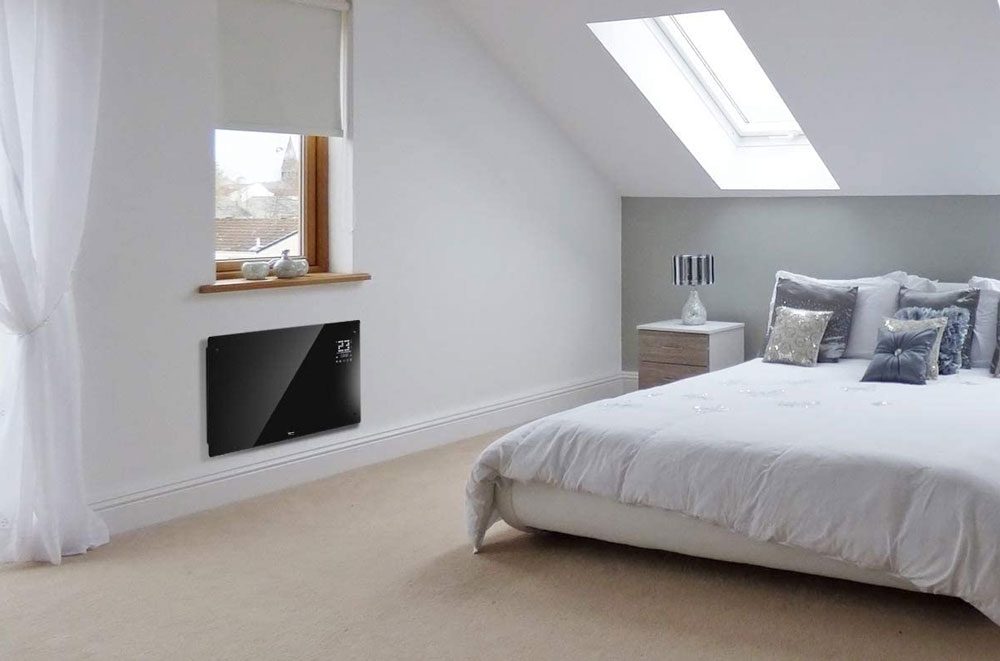
First off, just look at the thing; it more closely resembles an oversized iPad than your gram’s clunky old radiator! Indeed, it projects just 8cm off the wall once it has been installed, and is a truly modern accent for any home.
Beyond aesthetics, the WH-24P delivers performance in spades. Its 100% efficient, 2000W heating element powers out convection heat sufficient for rooms up to 22m2.
There are three preset modes of operation:
- Comfort mode spares no effort to get you as warm as possible;
- Eco mode saves you money by shutting off once the thermostat setting has been reached, and only reawakens once a full 3° drop has occurred;
- Anti-Frost mode maintains just enough heat to ensure extended periods of disuse and frost don’t damage the components.
In any mode, there’s an “instant on” manual override that allows you to take full control at any time. But it’s not just manual control that Wärme allow. The WH-24P has WiFi capability, and can be fully programmed with Wärme’s lightweight mobile app. What’s more, you can integrate it with your smart home system, like Alexa or Google Home for the ultimate in efficiency.
CONCLUSION
Not enough? The WH-24P from Wärme has overheat protection, plus IP22 waterproofing to allow usage anywhere in the house. It’s just 9.3kg at 78 x 8 x 47 cm, making installation manageable for anyone with basic DIY skills. Indeed, the ease of deployment, efficiency, and value for money of the WH-24P makes it a first-pick for property developers across Europe. Wärme backs each purchase with a generous 2-year warranty, so buy in confidence.
2. Devola Eco Slimline Panel Heater
If you’re looking for all the premium features, but need a bit more choice as to size, check out the Devola Eco line of Slimline Panel Heaters.
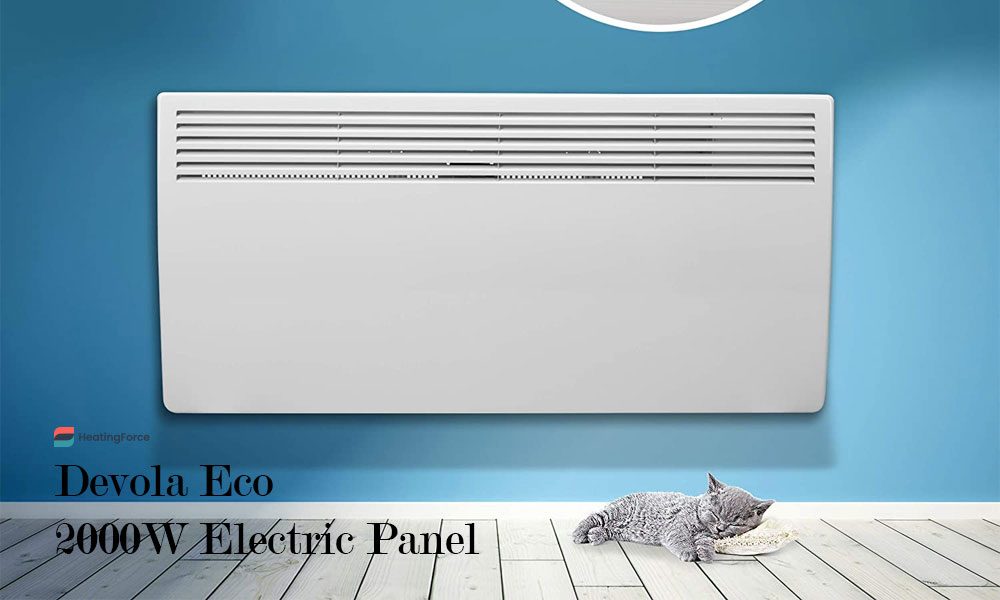
There are four models on offer: 1000W, 1500W, 2000W, and 2400W. Other than their physical dimensions and power output, they share an identical feature set. Foremost of these is the highly accurate digital thermostat, which is accurate to within a half degree.
What’s more, Devola complies with Lot 20 safety and efficiency standards. Features needed to achieve this rating include overheat protection; a child lock on the control panel; and open window detection which cuts the power when it detects a sudden drop of 5° or more.
There’s a highly sensitive thermal safety sensor, which locks the unit out if it ever surpasses the safe temperature threshold. Rounding the package out is anti-frost protection and a 2-year guarantee. The Eco is a truly dependable unit, and owners regularly report a long, uneventful service life.
CONCLUSION
Installation is DIY-friendly, and the Devola Eco ships with all the mounting hardware you’ll need. The cable is 1.5m long, and escapes from the right side of the unit. With its IP24 rating, you can safely deploy your Devola in Zone 2 of the bathroom or kitchen, though you’ll want to hire an electrician to waterproof the plug. All in all, you’ll be hard-pressed to find more value for money and flexibility under £100 than with the Devola Eco.
3. Wärme WH-20P Designer Electric Wall Heater
Wärme makes electric wall heaters so nice, they feature twice on best-of lists everywhere! All kidding aside, the WH-20P is essentially the same heater as the aforementioned WH-24P.

The biggest difference is a less glamourous backlit LCD screen, and the lack of WiFi-enabled smart functionality. But if you’re the type who just needs a fantastic device to warm your bones without all the bells and whistles, the WH-20P may be just the ticket.
To review: Wärme offers 100% energy efficiency (which means none of the energy drawn from the mains goes to waste on the way to heating element), and thus lower monthly energy bills. You’ve got a fully programmable thermostat and 24/7 timer; the WH-20P also offers a convenient memory function to store your preferences even if the power goes out.
As with its newer counterpart, there’s certain a “wow” factor to be had with the WH-20P. At 82 x 8 x 47 cm, and the slim-line, glossy black façade resembles a futuristic starship panel rather than an ordinary radiator. But the core of the Wärme is in its 2000W of convection heat production, which is ideal for rooms as large as 22m2.
CONCLUSION
Installation is a cinch even for novice DIYers; all the required mounting hardware comes standard in the WH-20P box, and doesn’t require specialised tools beyond a screwdriver. As there are no moving parts or complex components to break, you’ll find your Wärme is a maintenance-free purchase. And if something does go wrong, there’s a 2-year manufacturer guarantee on parts and labour. All in all, if you don’t need to connect your heater to Alexa, your value for money is found with the WH-20P.
4. Adax Neo Basic NP
Adax are no stranger to our website, and we commonly recommend their Neo series for a wide variety of applications around the home or office.
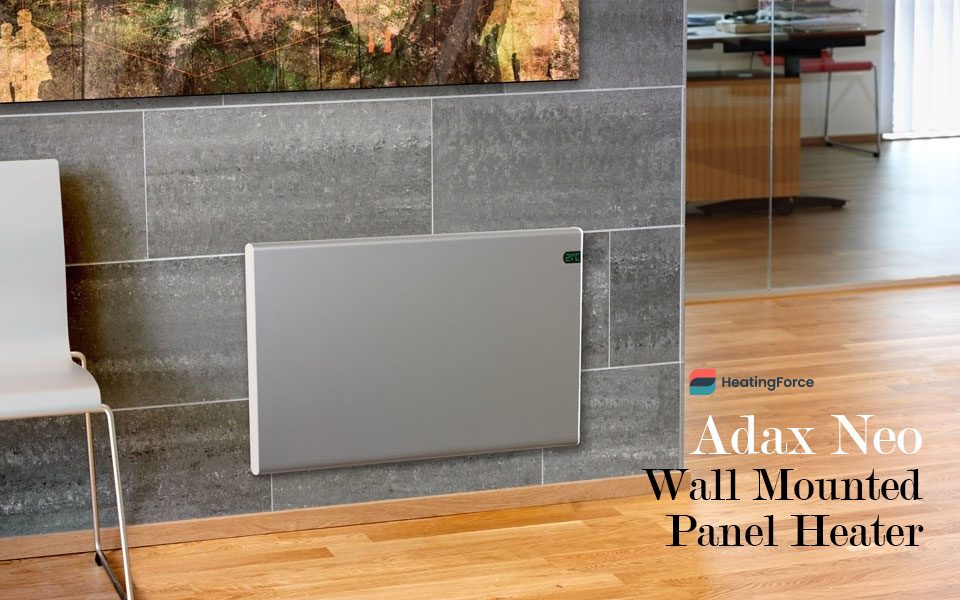
In terms of aesthetics, Adax has created something truly special with the Neo. To be sure, this model wears its Nordic heritage on its sleeve, with a minimalistic façade just a few centimetres deep.
There’s an attractive mini LCD window in the top right, with integrated control buttons sitting flush inside the frame. It’s the kind of design that makes an immediate impression, yet blends seamlessly into any modern household’s décor.
But this isn’t a beauty contest, of course; Adax makes an exceptional home heating solution no matter which of their six models you choose.
The Neo range starts at 400W–good for 6m2 rooms–and goes up to 2000W for spaces up to 25m2. Each features the same proprietary insulated aluminium alloy heating element, which reaches nominal temperatures within minutes. It’s dead-silent, and doesn’t burn dust or allergens off into the air like most convectors do.
Other smart features include an all-digital thermostat, 24/7 programmable timer, open window detection, child lock, and anti-frost mode. Also on board is a unique adaptive start system, which “learns” when to power on in order to meet your desired temperature according to schedule.
CONCLUSION
The Neo features IP20 construction–plenty to keep out all manner of airborne debris. It’s not enough within Zone 2 of your kitchen or bathroom, but an electrician can safely install the Neo in Zone 3. Anywhere else in the house or office, and you can handle installation yourself. It’s lightweight, and comes with all the hardware you need to mount it on the wall. All models protrude just 84mm from the wall, making the Neo a true slim line heating option.
5. Devola Classic Wall Mounted Panel Heater
Devola makes a triumphant return to our list with its Classic line of panel heaters. Available in 1500W and 2500W variants, the Classic functions admirably in any room in the house.
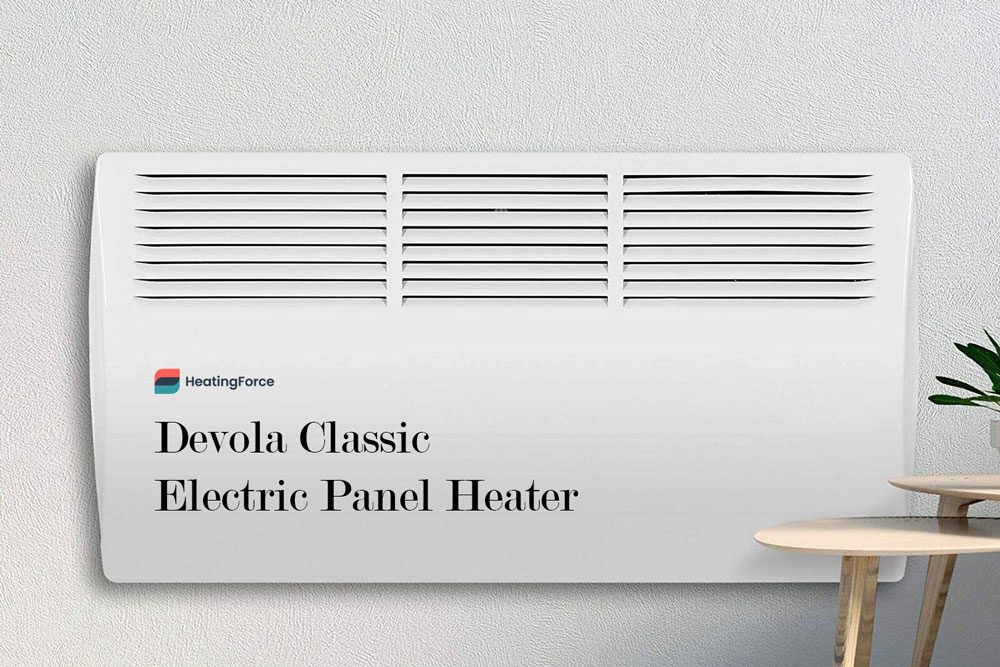
It features an outstanding thermostat that boasts accuracy within a half degree, programmable with a 24/7 digital timer. Even more, you can set weekly heating schedules up to four weeks in advance, so you have full control over your power bill with Devola.
The Classic is Lot 20 compliant, and as such features a premium array of safety and security features. These include a child lockout, overheat protection, open window detection, plus anti-frost settings.
The latter is one of three default programmatic settings, the other two being Comfort and Eco mode.
- Comfort utilises the full power of the Devola to deliver fast convection warmth;
- the Eco mode mirrors your Comfort programming, but 3.5° less to save energy.
In terms of styling, the Classic is the very archetype of a slim-line wall heater. Its façade is modern, clean, and unpretentious. While only white is available, the Devola should still comfortably match most modern home décor.
CONCLUSION
Neatly hidden behind the front panel is a crystal clear, blue backlit LCD display flanked by 5 robust control buttons. The operator’s manual is written in Plain English, and anyone with a modicum of DIY skill will find installation a breeze with the included hardware. User reports long product lifespans with the Classic, and Devola stands by their workmanship with a 2-year guarantee.
6. Purus Eco Electric Heater
Once again, we find ourselves recommending a range of models rather than a single unit. The Purus Eco Electric Heater comes in 600W, 1200W, and 1800W variants, and each provides exceptional performance and value for money.
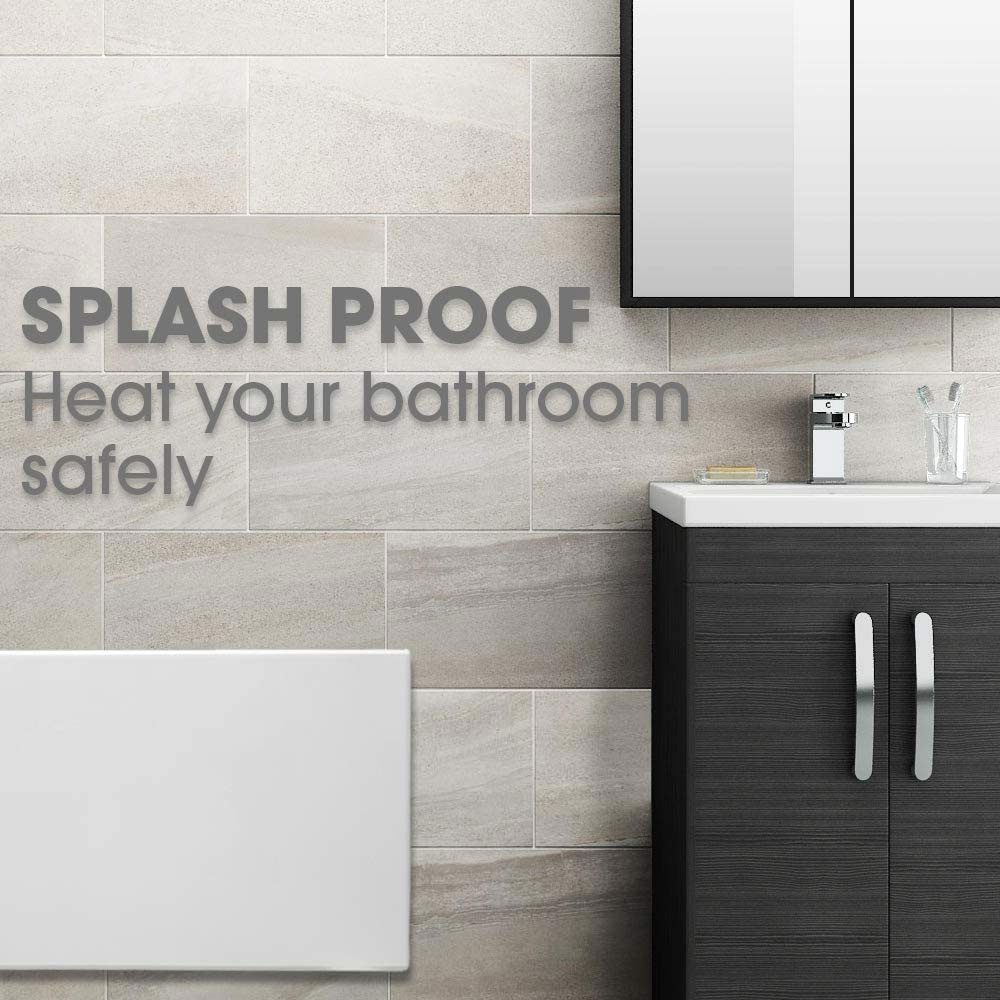
Unlike so many wall panels which claim to be “bathroom ready”, the Purus Eco features IP24 construction. (This means that it’ll withstand direct splashes as easily as the humidity of a hot day.)
Also unique to the Eco is the ability to deploy as a wall-mounted or free-standing unit. Whichever method appeals to you; Purus includes all the necessary hardware right in the box.
You can even install the Eco directly under a window, as its open-window detection intelligently responds to sudden temperature drops of 5° or more by shutting off.
They don’t advertise this nearly like they should, but the Purus Eco is actually one of the thinnest panel heaters out there, at just 70mm! Its slim profile further lends itself to deployment anywhere in the home or office–and strikes quite the pose amongst your décor.
CONCLUSION
We further appreciate that this convector is 100% efficient transmuting mains power to heat. Output is fully controllable between 5-35°, thanks to a highly sensitive digital thermostat (accurate within ½°). If you’ve got kids, never fear! There’s a child lock to keep curious fingers away from dangerous or wasteful settings. Overall, the Purus Eco’s robust design begs to be used anywhere and often. It helps that there’s a 2-year warranty to back it all up, as well.
7. Stiebel Eltron CNS 100-U
It might be last on our list, but the Stiebel Eltron CNS 100-U is quite possibly the most durable of all our recommended electric wall heater. If the name didn’t give it away, Stiebel’s CNS 100-U is a 100% German-made unit, and built to withstand robust usage.
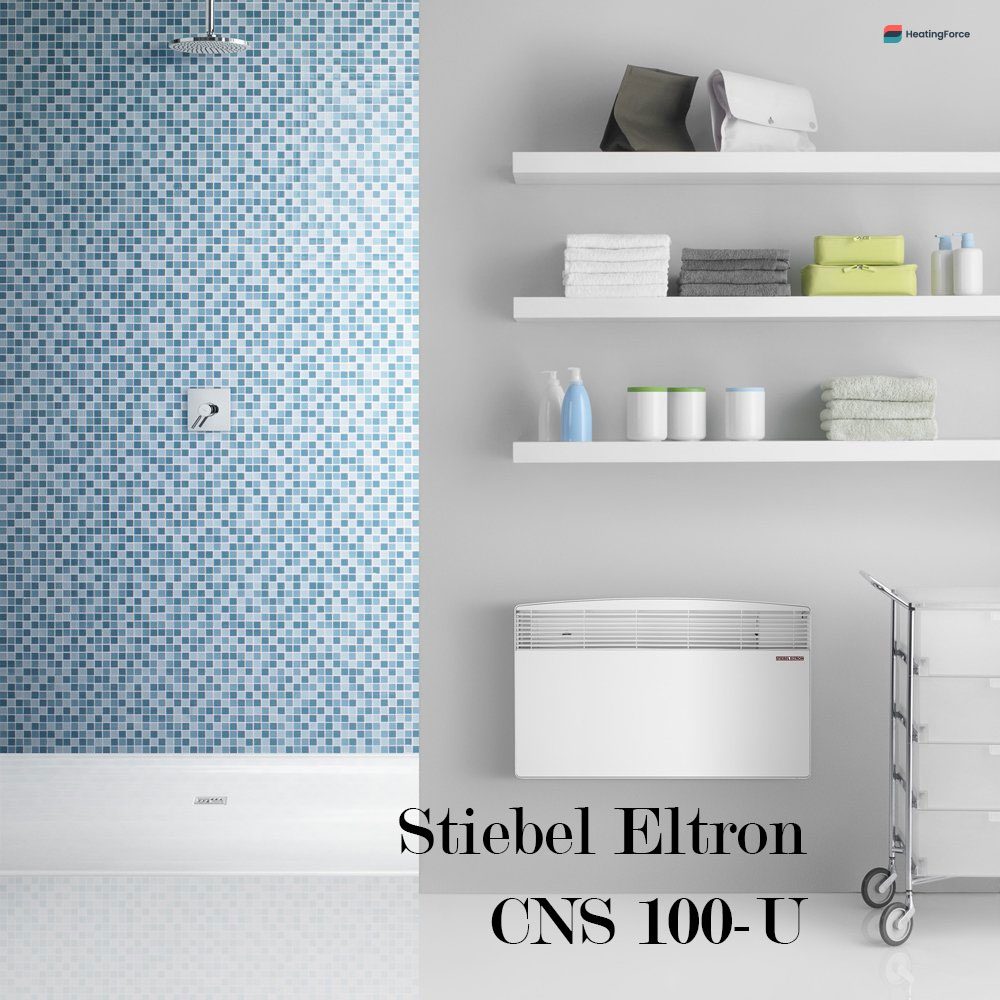
It won’t win any awards for beauty, though some may find its simple industrial aesthetic has a certain charm.
The casing is a combination of metal and hard plastic, which together form an IP24-rated moisture seal. This means the Eltron CNS 100-U is equally at home in your office or sitting room as it is in your bathroom after a steamy shower. We can also recommend the Stiebel for use in bedrooms, as there are no obnoxious neons or sounds to keep you up at night.
The CNS 100-U has a little brother in the CNS 50-U, which we recommend for all the same reasons, though for smaller spaces. Whichever you choose, you’re sure to appreciate the fact that neither is more than 13.4cm deep. Both are dead-simple to install, and come complete with the required mounting hardware.
CONCLUSION
When you need to make adjustments, there’s a simple roller dial thermostat which operates between 5-30°. At its lowest setting, you activate the anti-frost feature, which guards your investment against prolonged periods of disused during cold weather. While the Stiebel Eltron is one of the least expensive electric wall heaters on our list, it’s easy to recommend as exceptional value for money. Stiebel guarantees their products for up to 2 years, so you can buy in confidence.
How to shop for electric wall heaters in a crowded marketplace
The heaters we’ve recommended above represent but a slice of what’s available. The sheer range of brands, feature sets, and price points can be overwhelming for anyone not intimately acquainted with heating. Unless you’re highly resistant to analysis paralysis, it’s very likely blind comparison shopping will turn out to be more trouble than it’s worth.
That’s why we’ve compiled this short buyer’s guide. Our goal is to highlight the most important features and considerations you need to keep in mind whilst shopping around for electric wall heaters. Much of it is rooted in common sense; nevertheless, our advice will help you to select the best panel radiator to fit your heating needs and your budget.
Matching your heater to your room
Wattage
There’s a fairly straightforward relationship between how big your room is, and how many watts of power are needed to heat it. This is a generalisation, as different designs may be more or less effective in dispersing heat, but you want about 90W of power for every square metre, rounded up.
If you’re unsure about your specific requirements, we recommend you err on the side of caution and buy a heater which is too powerful, rather than not powerful enough. A 3000W heater is clearly overkill for a 15m2 space, but most heaters have some sort of power cut to better serve smaller rooms. An undersized heater, on the other hand, will struggle to meet the number you set on its thermostat. Not only will it fail to keep the cold away; it’ll burn an excessive amount of energy trying (and failing) to achieve its goal.
Heater type
Power isn’t the only factor in determining how successfully a heater can be in meeting your needs. Consider how you’ll use it as well. If you need something to help you defrost quickly, consider a forced-fan heating system. They’re less efficient, loud, and can upset allergies–but they heat up extremely quickly and warm your bones as soon as you set foot in the door.
On the other hand, if you need a continuous heat, a standard convector or even an oil-filled radiator will serve you better. They take longer to achieve nominal temperatures (especially oil-filled radiators), but they’re quite a bit more efficient in doing so. They tend to be quiet as well, since the eschew fan-blown heat in favour of fancy physics which naturally circulate warm air. There’s no exposed heating element either, so dust particles and other irritants won’t upset your asthma or allergies.
Understanding Lot 20 and essential efficiency features
Unless you’re an expert on energy legislation or the electric heating industry, the oft-advertised Lot 20 accolade is unlikely to mean much to you. However, products with this designation are well worth a second look, as they feature vital safety and efficiency provisions.
FYI, Lot 20 is an EU regulation, but it still applies post-Brexit. Contrary to popular belief, Lot 20 actually lowers the price of consumer heaters, as it heavily incentivises manufacturers to select more efficient materials and designs. What’s more, your monthly power bill will see dramatic reduction with Lot 20 appliances.
Now, the Lot 20 label doesn’t denote a specific list of features. Instead, it points to a minimum efficiency rating of 30%, which may be achieved through any combination of high-efficiency design features. Each feature is worth a certain number of points, and they all add up to meet with Lot 20 regulations for overall efficiency.
Here we cover a few:
Highly accurate thermostats
To ensure the proper amount of energy is drawn and not wasted, an accurate thermostat is needed to regulate output. Thermostats also tie into overheat protection systems, as they sense when your heater has exceeded safe parameters.
Programmable timers
You’re not home all the time, so why should your heater be running with you there to enjoy it? Programmable timers are essential safety and efficiency features, as they give you a large degree of control over when your heater is and isn’t in use. They also help you adapt the power output to match the changing ambient temperature throughout the cycle of day and night, and across seasons.
Adaptive start
When you programme your radiator for 25° at 5 o’clock in the afternoon, it will normally just begin heating at that time. But with adaptive start, the heater will read the ambient temperature in the hour leading up to 5:00. Then, it’ll calculate how soon beforehand it needs to start up so that it 25° are ready for you at 5:00 sharp. This makes it less likely that you’ll walk in the door, feel it’s still too cold despite your timer, and knock it to full blast to compensate. The implications for energy savings are obvious and many.
Open-window detection
If you set your thermostat to 25°, but then open up a window to a 5° chill, much of your interior heat will rush right out. Without open-window detection, your heater will sense this sudden loss of heat, and draw full power to bring it back to 25°. Of course, it may never reach that temperature so long as the window is open, so you’re just wasting an excessive amount of energy in a vain pursuit at best. At worst, the heater’s overcompensating can lead to components becoming dangerously hot, risking fire or electrocution.
Open-window detection is one of those things that doesn’t sound as necessary as it is. Instead of overcompensating, a radiator equipped with this feature will wait politely for you to shut the window. Only then will it resume heat production–under more favourable circumstances. It’ll still have to burn a bit of extra energy to get back up to 25°, of course, but this climb will only happen when there’s a guarantee of success.
Safety features
You’re trusting your radiator to get very hot without burning your house down. So, it’s reasonable to expect modern heaters to have certain fail safes in place the prevent dangerous operation. We recommend you pay special attention to the following provisions:
Overheat protection
This is the most basic form of protection your radiator can have, and it really is essential. The cut-off point for most radiators is around 75°, though it can be less or more depending on the size and type of heater. The thermostat is often responsible for monitoring excessive temperature spikes, though there might be a separate, dedicated sensor to do this job as well. Once this threshold is reached, the overheat protection module will lock out the entire heater, preventing any more power being drawn from the mains.
We recommend you take a hard pass on any wall-mounted radiator which doesn’t make this basic promise for your safety and peace of mind, no matter the price.
Child locks
You know how young children can be, with wandering fingers to match curious minds. Should they begin to meddle with the thermostat or timer, they may select settings which are either wildly inefficient, uncomfortable, or even dangerous.
Sure, the overheat protection will likely prevent disaster befalling your household as a result of your child selecting maximum heat. However, it’s best to simply deny them the privilege of setting the heater until they’re old enough to do so responsibly. Passwords can be effective, as can specific combination of buttons to unlock the control panel.
Anti-frost mode
This could easily be categorised under efficiency settings, as it is indeed one of the many features that can fulfil Lot 20 regulations. However, we tend to consider it a safety feature foremost.
Now, it’s true that electrical wall heaters are less susceptible to the ravages of bitter cold. After all, there’s no water involved, nor pipes to burst. However, metal contracts in the cold, which can lead to cracked solder joints or short circuits. With the electronics gone haywire, you run the risk of fire or electrocution.
Anti-frost mode simply runs a minimum power draw needed to keep all the components at a baseline temperature. It sips energy off the mains, and typically does not lead to a dramatic spike in your monthly energy bill. If you live in a particularly cold area, you plan to keep your heater in a less-insulated room like a conservatory, don’t skip this essential feature.
In conclusion
Today, we’ve reviewed the top-rated electric wall heaters currently on the market. We made our selections for energy efficiency, sheer performance, durability, user satisfaction, and overall value for money. You can be confident that our selections are proven reliable in the field, and will add to the décor of your home.
Do you have any other essential heating features our buyer’s guide missed? What sort of panel radiator are you in the market for? Leave us a comment below
